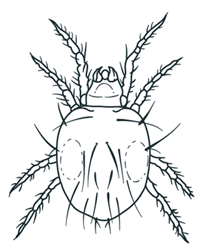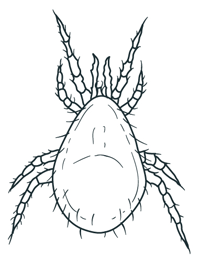
 |
|
Hydroponics - Indoor HorticultureHydroponics - Indoor Horticulture represents an educational, in-depth,
up-to-date,
indoor horticultural growers guide that covers all principles of indoor Hydroponics - Indoor Horticulture examines, explores, dissects and
presents a fully comprehensive step by step growers guide, relating
to all and every aspect of indoor hydroponic horticulture, with complete
chapters on plant biology, propagation, hydroponic systems, nutrients,
oxygen, carbon dioxide enrichment, pH, biological pest control, fungi/disease,
cuttings/clones, pruning/training, breeding, harvesting, equipment,
grow rooms, a full history of hydroponics, and more. |
(Below
follows a one page sample taken from the book) Red Spider Mite (Two-Spotted Mite)
 A small mite which is yellow or olive-coloured with dark patches on both sides of its body. They measure less than 1 mm in length and can appear in large numbers on the undersides of leaves. In due course, they create fine webs that cover the plants on which they walk. In autumn, the mites turn deep red in colour. Preferred Host PlantsA wide range of C3 plants, glasshouse vegetables and ornamental plants. DiagnosisThe mites extract the contents of the leaf cells which produces a mottling effect on the upper leaf surfaces. Heavy infestations produce the characteristic webs and if not controlled, the leaves go brown and drop off and the plant may die. Life CycleThe eggs are deposited on the underside of the leaf. There are five development stages and egg to adulthood takes about 14 days at 21°C, and less than a week at 30°C. Adult females can produce more than 100 eggs over 3 weeks. The reproduction rate from one generation to the next is approximately 31 times! In the autumn, when days are less than 13 hours long, the mites turn deep red and leave to hibernate in nooks and crannies in the glasshouse. They can overwinter without feeding, and emerge in the spring and summer to infest crops once again and with artificial lighting, they may only hibernate for very short periods of time (between crops), or they may not even hibernate at all. Humid environments that are higher than 60% RH can diminish the egg production of a mite. Biological Pest ControlPhytoseiulus Persimilis This is a predatory mite originally from Chile, and is |
somewhat larger than the
two-spotted mite. It has a pear-shaped, shiny, red body, long legs and
moves ery quickly as it searches for its prey. The young are oval-shaped
and a very pale pink colour. Phytoseiulus usually comes mixed with vermiculite
carrier grains which are shaken over the infested crops.
Life CycleEach mite can lay between 50-60 eggs over a period of 3 weeks. Egg to adult takes about 12 days at 20°C and about a week at 30°C. Hundreds of spider mites can be eaten by a single predator during its life, and all stages of Red spider mite are acceptable to the predator. Once established, the predator can rapidly overwhelm the pest, which isn’t difficult, as the mite population increases 44 times in one generation!! If all the pests are eliminated, the predator will scatter and die.  Procedure Phytoseiulus should be introduced as soon as mites are spotted. The air temperature must reach about 20°C for at least some of the day, and humidity needs to be kept quite high at above 60% RH by damping down or misting. Red spider mites aren’t particularly fond of high humidity and misting in conjunction with the release of phytoseiulus will bring the mites under control more quickly. Sometimes, the predator is so successful and completely eradicates the spider mite, so it may need to be reintroduced if further infestations occur. NB – There are several other mites that can be classed as pests in the grow room and even more that are harmless or even beneficial. A relative to the Red spider mite is the Carnation spider mite, tetranychus cinnabarinus, and as the name implies, often causes trouble with carnations. The Broad mite is tiny and almost colourless and can cause leaves on ornamentals to go brown. Its relative, the Cyclamen or Strawberry mite, causes leaves and buds to deform. Phytoseiulus is not particularly proficient at wiping out these mites. However, intensely red, fast moving mites that seem to have a pair of legs in front of them are predatory Trombid mites and are harmless. |
|
 |